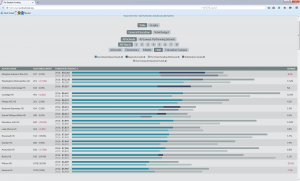The differences among DCPS schools in their “per-student” funding — a metric closely watched by parents and policymakers alike — may not be as great as you thought, based on a new interactive online tool released today by a coalition that includes DCFPI and S.H.A.P.P.E. The new data visualization tool compares each school’s “general education” budget — basic funding before extras for things like special education are added. Because the extras can add a lot to some schools but not others — based on differences in the number of students needing special services — a general education comparison offers a cleaner comparison of how schools are funded.
But the new tool also shows that the way DCPS allocates general education funding is not always consistent or clear. For example, some schools get “specialty funds” while other similar schools do not. This highlights the needs, as a matter of fairness across schools, for new funding policies that are clear and consistently applied.
Launched today by the Coalition for DC Public Schools & Communities and Code for DC, the interactive tool shows how both general education and overall funding were allocated by DCPS across schools and how those allocations will change between this school year and next. By clicking on an individual school line, you can see details on how the school’s enrollment and budget will change from fiscal year 2015 to 2016.
This tool shows why we should compare school budgets through a general education lens. The “total budget” includes general education funding, plus added resources for students who require special education supports, are considered “at risk” or have limited English proficiency. The interactive tool confirms that the schools with more total funding per student tend to serve high numbers of students with additional challenges. Per-student funding at Roosevelt High School, for example, looks much different when all the specialized funds are taken out of the picture – less than $8,000 per student in general education funding compared with $15,000 in the total budget view. Roosevelt’s total funding per student may look much higher than other schools, when much of that is not in reality available to all students.
But even when the specialized funding is stripped away, the tool also shows that some schools receive additional funding while others do not, and these decisions are made at the discretion of DCPS. For example, if a school’s total funding falls below a certain per-student floor — $9,000 for 2015-16 school year — the DCPS budget guideline indicates that its funding should be increased to meet the minimum. However, in FY 2015-16, the per-pupil funding minimum is not guaranteed or uniformly applied. Wilson HS, though seemingly eligible for support from the per-pupil minimum, did not receive any such funds from DCPS for 2015-16.
Likewise, another funding source called “specialty” funding has been expanded to some schools, while others were left out. The criteria DCPS uses to decide which schools qualify for specialty funds — and how much — are not specific or transparently applied. For example, specialty funds will go to Brookland Middle School for arts, to Jefferson Middle School for International Baccalaureate (IB) and to Woodson High School for its STEM program. Banneker High School, an IB school that received specialty funds in the past, will receive them next year, but Eastern, another IB high school, will not.
We feel it is important that DCPS schools have consistent funding and policies to rely on from year-to-year.
- Revisit the staffing formula. Each school’s general education funds should be adequate to pay for the basic teachers and administration each school needs. Looking to next year, DCPS should revisit its “staffing formula” to take into account school size (how many students) and type (elementary/middle/high school). Right now, for the most part, administrative staff — such as the principal, assistant principal, or attendance counselor – are funded at the same level across schools regardless of how many students attend or what ages they serve. The formula should reflect the different staffing needs of schools of different sizes and type.
- Adopt consistent policies for budget allocations within DCPS. It is important that budget allocations from DCPS to individual schools are governed by consistent policies. Schools and parents need to know whether or not certain funding will be available so that they can plan effectively, and they should be able to see that their school has been funded fairly. This requires consistent, transparent criteria and uniform application for funding policies, such as the Per Pupil Funding Minimum and specialty funding, if they are still to be used.
- Continue to improve budget transparency. We applaud DCPS for working with the Coalition to inform the data project, but more is needed to ensure the community has a role in and then understands the decisions behind their school’s budget. For example, the city should reconvene a budget task force comprised of community members, parents, school and central office staff to work through budget recommendations starting in the fall.
We encourage you to check out the tool yourself by visiting http://fy16budget.ourdcschools.org/
Cathy Reilly is Executive Director of Senior High Alliance of Parents, Principals and Educators, or S.H.A.P.P.E. (www.shappe.org).
To print a copy of today’s blog, click here.

